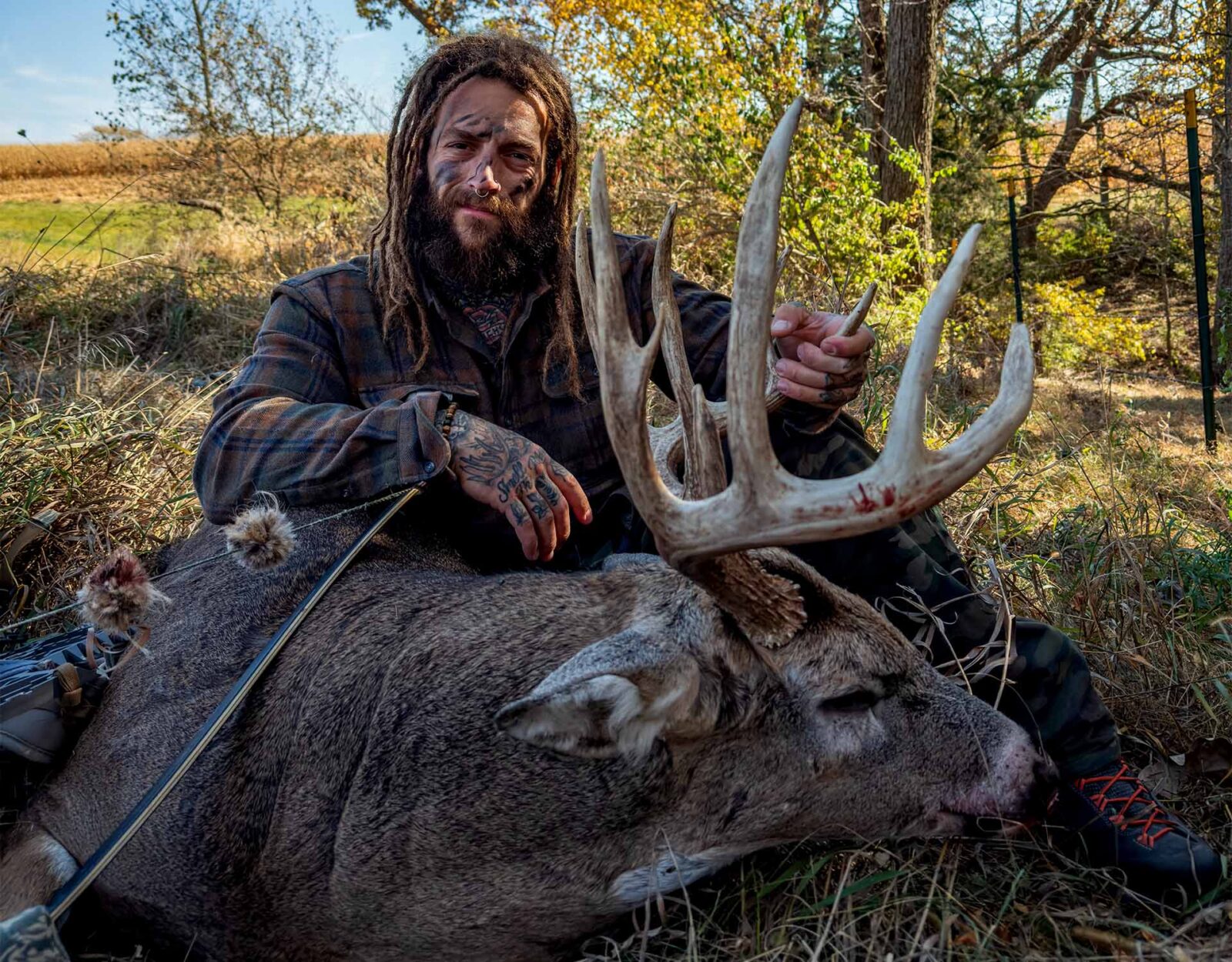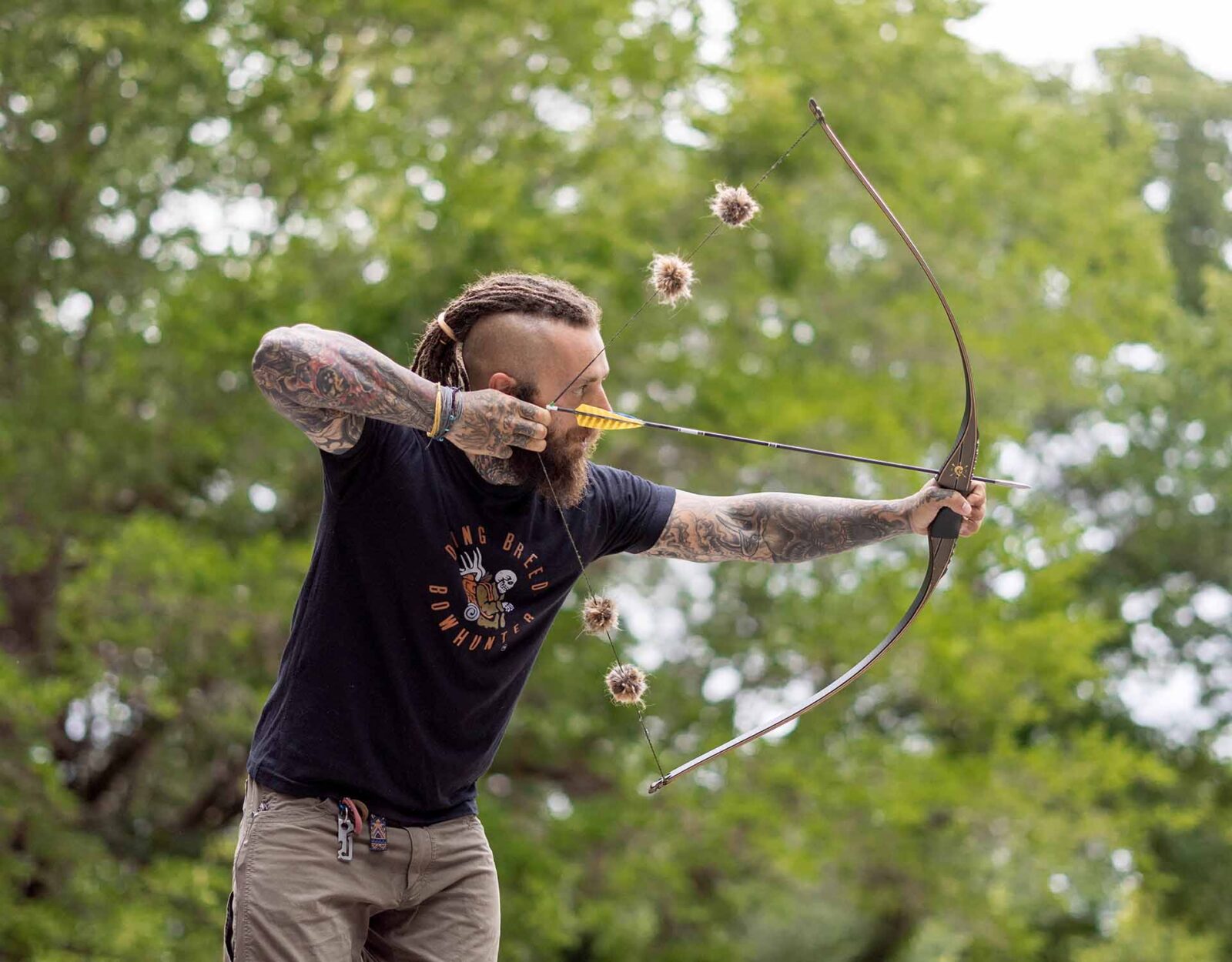In an era of high-tech gear and laser optics, traditional archery might seem like a nostalgic footnote to many hunters. But to those who wield a traditional bow, or “trad bow,” it represents something profoundly different. A discipline. A connection. A way of hunting that strips away everything except the essentials.
For Cody D’Acquisto, a lifelong whitetail hunter and founder of Dying Breed Bowhunter, traditional archery isn’t a quaint nod to the past. It’s a personal mission. “Even walking through the woods with a traditional bow is different,” he says. “It just feels different. There’s an aura about it.”
Types of Stickbows
Traditional archery revolves around three primary bow types: the longbow, recurve, and selfbow. All share a simplicity that modern compounds have long abandoned.
- The longbow, with its D-shaped profile and soft draw cycle, offers a quiet and smooth shooting experience.
- The recurve bow, named for its distinctive curved limbs that face away from the archer, packs more power into a shorter frame, ideal for maneuverability in brushy environments.
- Selfbows are one-piece bows typically carved by hand from a single stave of wood. Typically hand-carved by the archer.
But even among trad archers, there’s room to improvise and lean into the appeal of non-conformity. Cody hunts with a compact 52-inch longbow built by Bushmen Bows.
“I needed a tiny longbow,” he explains. “Most traditional bows are 64 inches or longer, but I hunt dense cover. I wanted something with purpose. When I told Steve at Bushmen I wanted a ‘tiny longbow,’ he laughed at me. Now he makes those bows.
“I’ve shot two great whitetails with it and just put a turkey down a couple weeks ago,” says Cody. It’s a setup honed for lethal efficiency at close quarters.

Why Simple Feels Better for Some: The Draw of Primitive Bows
Cody’s evolution toward traditional archery wasn’t impulsive. “Even as a kid, I always knew traditional archery was where I wanted to land,” he recalls. Raised in Wisconsin by a pioneering bowhunter who founded Lone Wolf tree stands, Cody hunted exclusively with a bow from age 12.
“My entire life, every deer I’ve ever killed, every hunt I’ve ever been on, has been with archery equipment,” he says.
He fully committed to the trad bow world after he shot his dream buck with a compound bow. “That was almost like the end,” he says. “I put the compound away and haven’t touched it since.”
Traditional bows, to Cody, offer a closer bond with the entire hunting process. “I’m not into archery for the archery. I’m in it for the woodsmanship. I want to get as close to the animal as possible.”
The switch better reflected his minimalist hunting style: no camo, no trail cameras, no excess tech. “The thicker your shoes are, the less you feel the ground. I apply that to hunting. I want minimal gear.”
“That was almost like the end,” he says. “I put the compound away and haven’t touched it since.”
Cody D’Acquisto

Traditional vs. Compound Bows: Key Differences for Bowhunters
The difference between traditional and compound bows is more than mechanical. It’s philosophical. At the heart of it, you’re comparing a mechanical system engineered for consistency against a manual tool that rewards muscle memory and mental focus.
Compound bows feature high let-off cams—often 65-85%—meaning the hunter only holds a fraction of the draw weight at full draw. This allows for steadier aim and longer hold times. Compound bows incorporate sights, stabilizers, arrow rests, and release aids that collectively create a system designed for repeatability. When properly tuned, a compound bow can shoot arrows in tight groups at distances of 60, 70, even 80 yards.
Traditional bows, by stark contrast, demand mastery of instinct and require the archer to hold the full draw weight through the shot. There are no cams to reduce tension, and most traditional archers shoot with fingers, not a mechanical release. Aiming is often done instinctively, as Cody does, or through methods like gap shooting or string walking. These bows generally have effective hunting ranges of 15-25 yards, and precision at longer distances demands exceptional skill. As Cody puts it:
“The more my mind strays, the more my arrow does.”
He warns newcomers about letting forums or online experts overcomplicate the process. “Pick something that feels comfortable and repeat it. Don’t play somebody else’s game.”
Cody also challenges the notion that beginners should drill in perfect form before they can hunt. “Some in the traditional community can be discouraging. I talk to many people every year who say, ‘I thought I was going to hunt this year with my traditional bow. And I don’t think I’m ready. I did this course with this person, and he told me that I’m not ready.’ It hurts my heart.”
While some traditional archers worry about wounded game, Cody’s approach solves that through woodsmanship and range discipline. “Even with a compound, I never shot a deer beyond 21 yards. My furthest shot ever is 21 yards. It’s about getting close.”
“Pick something that feels comfortable and repeat it. Don’t play somebody else’s game.”
Cody D’Acquisto

How To Build Your Traditional Archery Skillset
Cody’s method is simple, and that’s intentional. “Too much shooting can develop bad habits,” he says. “It can also get in your head. If you’re not shooting that great, all of a sudden you’re like, what am I doing wrong?”
Instead, he often takes one cold shot a day, realistically simulating what it feels like to draw and shoot at an animal.
“During hunting season, I have a designated arrow I shoot from my tree stand. After every hunt, before I get down, I pick a spot that is realistic to where I was set up and where the deer was going to come through. I’ll pick a leaf, a hedge apple, an acorn—something—and execute that shot. One shot. That’s my one practice shot a day that keeps me on.”
He also emphasizes functional fitness and strength training. “You don’t want to pull a bow cold with muscles you haven’t used.”
Cody believes deeply in personalizing your setup and style. “Some of the best athletes have ugly form. Who cares? If you’re grouping, don’t change just because someone says you should.”
When it comes to tuning, he does it just enough to understand his gear and keep it field-ready. “I carry a tiny repair kit with a string, serving, and lighter. If my string comes off, I can be back hunting in five minutes.”
“Some of the best athletes have ugly form. Who cares? If you’re grouping, don’t change just because someone says you should.”
Cody D’Acquisto
The Payoff
Hunting with a traditional bow is hard, but Cody insists the payoff is worth it.
“When you finally connect, I promise you the reward is tenfold. It’s different than anything you’ve experienced prior to that.”
His brand, Dying Breed Bowhunter, is a tribute to woodsmanship. And his choice of gear reflects that ethos. “The onX App is the only electronics I use. I believe in removing as many layers as you can to get closer to the experience.”
He offers this final encouragement to newcomers:
“Confidence in your gear is everything. The biggest thing with these bows is being confident. Pick something that works and don’t overthink it.”
In a world where hunting is increasingly augmented by technology—drones, cellular trail cameras, and range-compensating sights—traditional archery offers an antidote. Cody and others in the traditional archery community offer a return to something simpler, more primal, and—perhaps—more rewarding.
Want To Try Traditional Archery?
• Start with a 40-45-pound recurve or longbow.
• Focus on instinctive shooting or gap shooting.
• Keep practice distances short and sessions frequent. One great shot a day is better than 20 thoughtless ones.
• Don’t let online experts shake your confidence.
• Get close. Then get closer.